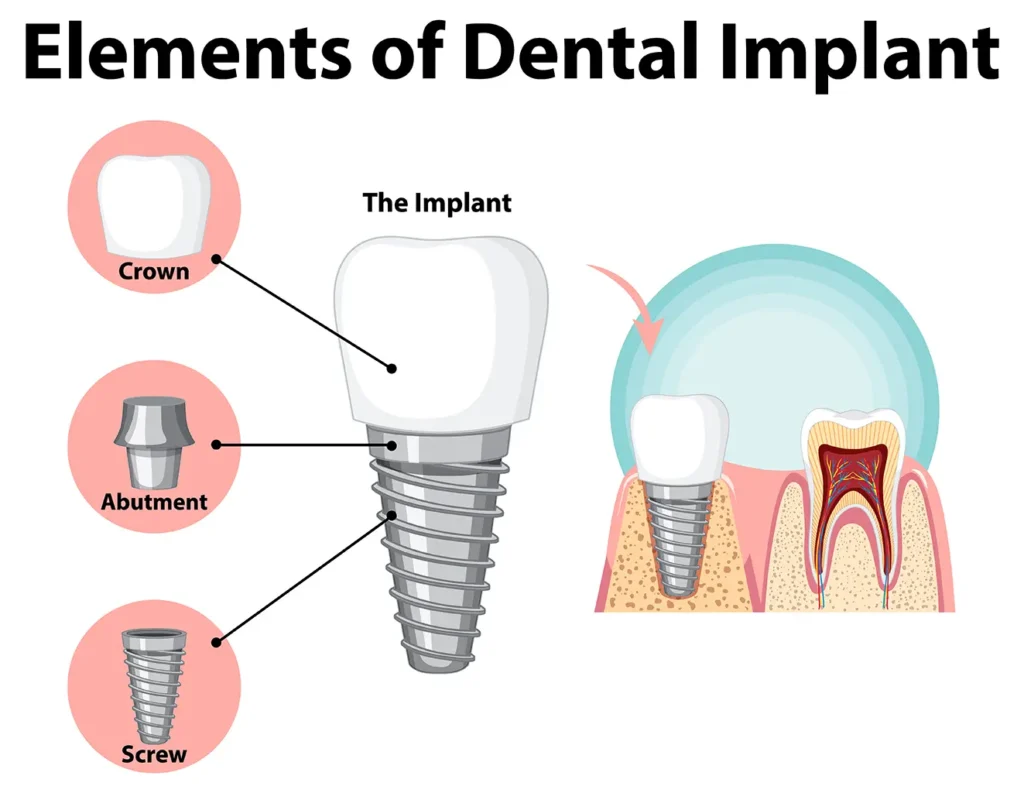Table of Contents
Dental implants have become a popular and effective solution for replacing missing teeth, offering both functional and aesthetic benefits. Whether you’ve lost a tooth due to injury, decay, or disease, dental implants can restore your smile and improve your overall oral health. However, one of the most common concerns patients have is about the recovery process. In this article, we will explore what dental implants are, the procedure involved, and what to expect during the tooth implant recovery time. This information is essential for patients considering this option at Montana Center for Implants and Dentures.
What Are Dental Implants?
Dental implants are artificial tooth roots that provide a permanent base for fixed or removable replacement teeth. They are designed to blend in with your natural teeth, providing a durable and long-lasting solution for tooth loss.
Components of a Dental Implant
- Implant: The actual implant is a small, screw-like post made of titanium, which is surgically placed into the jawbone. This serves as the root of the new tooth and provides a strong foundation for the replacement tooth.
- Abutment: After the implant has integrated with the bone, an abutment is attached to the top of the implant. This component connects the implant to the replacement tooth.
- Crown: The crown is the visible part of the tooth, custom-made to match the shape, size, and color of your natural teeth. It is attached to the abutment to complete the dental implant.
Types of Dental Implants
- Endosteal Implants: These are the most common type of dental implants. They are placed directly into the jawbone and are typically made of titanium.
- Subperiosteal Implants: These implants are placed under the gum but above the jawbone. They are often used for patients who do not have enough healthy jawbone and cannot undergo a bone grafting procedure.
Benefits of Dental Implants
- Natural Appearance: Dental implants look and feel like natural teeth. They are designed to fuse with the bone, providing a permanent solution that doesn’t slip or shift like dentures.
- Durability: With proper care, dental implants can last a lifetime. They are highly durable and resistant to decay.
- Improved Oral Health: Unlike dental bridges, implants do not require the alteration of adjacent teeth. This helps preserve the health of surrounding teeth and maintains the integrity of the jawbone.
- Enhanced Comfort and Functionality: Dental implants eliminate the discomfort of removable dentures. They also restore the ability to chew and speak with confidence.

The Dental Implant Procedure
Understanding the dental implant procedure can help alleviate any anxiety about the process. Here’s a step-by-step overview of what you can expect:
Initial Consultation
- Assessment: The first step involves a thorough examination by your dentist. This includes X-rays and 3D imaging to assess the condition of your jawbone and determine the best placement for the implants.
- Treatment Plan: Based on the assessment, your dentist will develop a personalized treatment plan. This plan will outline the number of implants needed, the type of implant, and the timeline for the procedure.
Tooth Extraction (If Necessary)
- Removal of Damaged Teeth: If you have a damaged tooth that needs to be replaced, it will be extracted before the implant procedure. In some cases, the implant can be placed immediately after the extraction.
- Healing Period: After extraction, your gums may need some time to heal before the implant can be placed. This healing period can vary depending on the individual’s oral health.
Implant Placement
- Surgical Procedure: The implant is surgically placed into the jawbone under local anesthesia or sedation, depending on your preference and the complexity of the procedure. The gum is then stitched over the implant to allow for healing.
- Osseointegration: After the implant is placed, a process called osseointegration begins. This is when the implant fuses with the jawbone, providing a stable foundation for the replacement tooth. Osseointegration can take several months, but it is crucial for the long-term success of the implant.
Abutment Placement
- Second Surgery: Once osseointegration is complete, a second minor surgery is performed to place the abutment. The gum tissue is reopened to expose the implant, and the abutment is attached. The gum is then closed around, but not over, the abutment.
- Healing Time: The gums will need a few weeks to heal after the abutment placement before the final crown can be attached.
Crown Placement
- Custom-Made Crown: After the gums have healed, a custom-made crown is created based on impressions of your teeth. This ensures that the crown matches the color, size, and shape of your natural teeth.
- Final Attachment: The crown is then attached to the abutment, completing the dental implant procedure. The result is a fully functional and natural-looking tooth replacement.
Tooth Implant Recovery Time: What to Expect
The recovery time for dental implants can vary depending on several factors, including the number of implants placed, the condition of your jawbone, and your overall health. However, understanding the general timeline can help you prepare for the process.
Immediate Post-Surgery Recovery
- First 24 Hours: After the implant surgery, it is normal to experience some discomfort, swelling, and minor bleeding. Dr. Josh Muir and Dr. Tanner Townsend will provide instructions on managing these symptoms, including using pain medication and cold compresses.
- Dietary Restrictions: You will need to stick to a soft-food diet for the first few days to avoid putting pressure on the implant site. Avoid hot foods and drinks, as they can increase swelling.
First Week of Recovery
- Managing Swelling: Swelling is usually at its peak 48 hours after surgery but should gradually subside within a week. Continue using ice packs and take prescribed anti-inflammatory medications as directed.
- Oral Hygiene: It is important to maintain good oral hygiene during recovery.
Dr. Josh Muir and Dr. Tanner Townsend will recommend rinsing with a saltwater solution or an antimicrobial mouthwash to keep the implant site clean. Please be gentle when you brush around the surgical site.
Healing Over the First Month
- Soft Tissue Healing: The gums around the implant will start to heal over the first month. It is essential to follow Dr. Josh Muir and Dr. Tanner Townsend’s instructions during this period to avoid any complications, such as infection or implant movement.
- Diet: You can gradually reintroduce harder foods as your comfort level increases. However, avoid biting directly on the implant site until your dentist confirms it is safe to do so.
Osseointegration Period
- Bone Fusion: Osseointegration is the process where the implant fuses with the jawbone, which is crucial for the stability of the implant. This process can take anywhere from 3 to 6 months, depending on the individual.
- Regular Check-Ups: During this time, you will have regular check-ups with Dr. Josh Muir and Dr. Tanner Townsend to monitor the progress of osseointegration. It is important to avoid any activities that could disrupt this process, such as chewing hard foods or clenching your teeth.
Final Recovery and Crown Placement
- Abutment and Crown Placement: Once osseointegration is complete, the abutment and crown are placed. After this final step, there is usually a short recovery period to allow the gums to heal around the crown.
- Complete Healing: After the crown is placed, the full recovery is considered complete. At this point, the implant should feel and function like a natural tooth.

Tips for a Smooth Recovery
To ensure a smooth and successful recovery after your dental implant procedure, follow these tips:
1. Follow Post-Operative Instructions
- Adherence: Carefully follow all post-operative instructions provided by Dr. Josh Muir and Dr. Tanner Townsend. This includes taking prescribed medications, avoiding certain foods, and maintaining good oral hygiene.
2. Manage Discomfort
- Pain Management: Use over-the-counter pain relievers or any medications prescribed by Dr. Josh Muir and Dr. Tanner Townsend to manage discomfort. Applying ice packs to the outside of your face can help reduce swelling and bruising.
3. Maintain Oral Hygiene
- Cleanliness: Keep your mouth clean by brushing and flossing regularly, but be gentle around the implant site. Using an antimicrobial mouthwash can also help prevent infection.
4. Avoid Smoking
- Healing Interference: Smoking can significantly delay healing and increase the risk of implant failure. If you smoke, consider quitting before undergoing the implant procedure to improve your chances of a successful recovery.
5. Attend Follow-Up Appointments
- Monitoring: Regular follow-up appointments with our dental team are crucial for monitoring the healing process and ensuring that the implant is integrating properly with the jawbone.
Conclusion
Dental implants are a reliable and long-lasting solution for replacing missing teeth, offering numerous benefits for both your oral health and quality of life. Understanding the procedure and tooth implant recovery time can help you prepare for what to expect and ensure a smooth recovery process.
At Montana Center for Implants and Dentures, we are committed to providing the highest level of care to help you achieve a successful outcome with your dental implants. Whether you’re beginning to explore your options or are ready to move forward with the procedure, our team is here to guide you every step of the way. With the right care and attention, your dental implants can provide you with a beautiful, functional smile for years to come.



